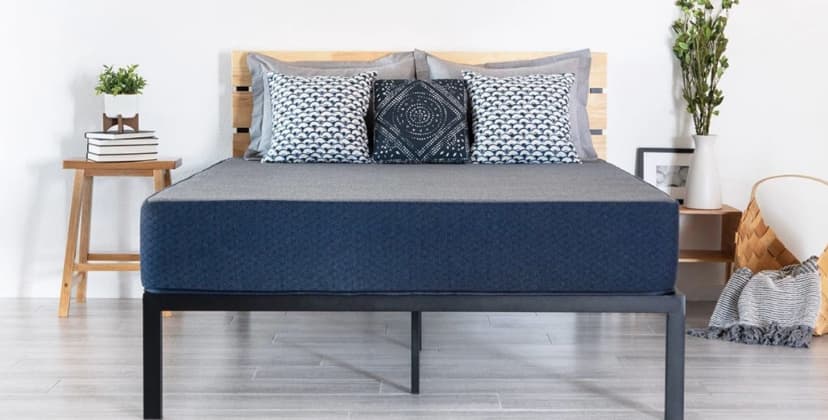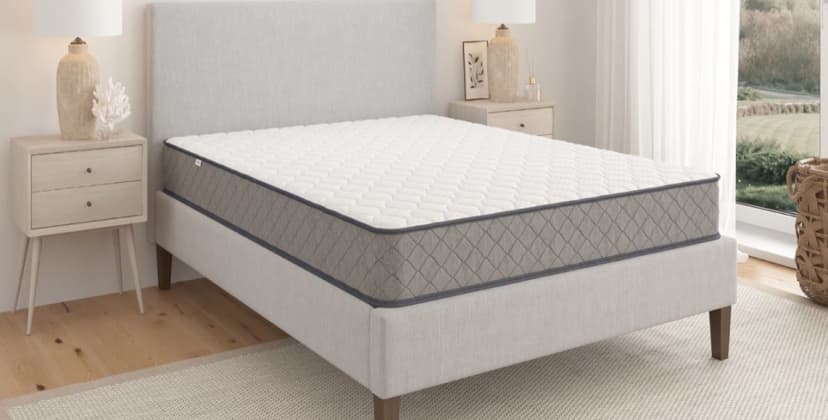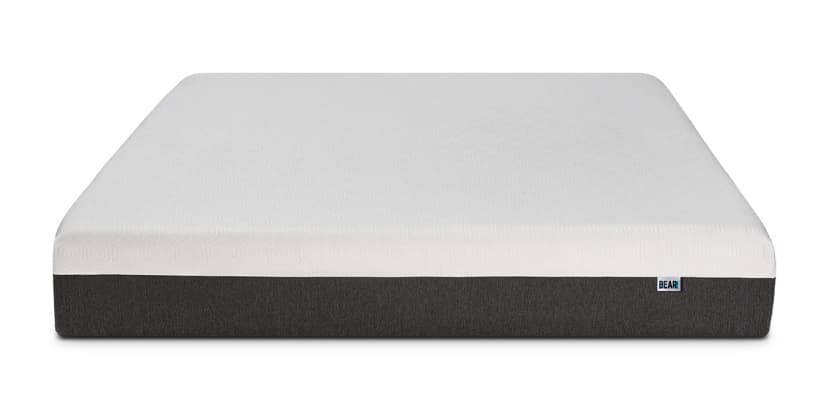When you buy through our links, we may earn a commission. Products or services may be offered by an affiliated entity. Learn more.
Standard mattress height is between 10 and 12 inches tall. Shorter mattresses offer several unique benefits when compared to those with standard or taller profiles. Thin mattresses are often easier to transport and less expensive, making them great for growing kids or guest bedrooms. RVs, loft beds, and certain foundations may require a thin mattress. Some people simply prefer the look of a thin mattress.
After considerable research and in-house testing, we’ve devised a list of our favorite thin mattresses. We also cover what type of sleeper is most likely to benefit from a low-profile mattress design.
In-Depth Reviews
Brooklyn Bedding’s Dreamfoam Essential is a versatile all-foam mattress. It’s affordably priced and available in multiple heights and sizes. The thinner 6-inch and 8-inch models are ideal for RVs, bunk beds, and trundles.
-
Pros
-
Comes in a variety of thicknesses and feels
-
Strong edge support for an all-foam bed
-
Available in multiple RV sizes
-
-
Cons
-
Thinner models feel too firm for lighter side sleepers
-
Responsive surface makes it easier to feel your partner’s movements
-
Mattress Type
Foam
Firmness Options
Medium Soft (4), Medium (5), Medium Firm (6), Firm (7), Firm (8)
Price Range
$206 – $862
Trial Period
120 nights (30-night requirement)
Why It’s Best Overall
The Dreamfoam Essential stood out to our team for its versatility and low price tag. Shoppers can choose from five heights and an array of standard and custom sizes. Our testers were impressed with the mattress’ sturdy edge support and great temperature control.
How It Performed
The performance of the Dreamfoam Essential varies based on the model as well as your sleep style and weight. The 10-inch model was popular with all of our testers under 230 pounds. It has a balanced medium firm (6) feel that suits all sleep positions. The 6-inch and 8-inch styles promoted even spine alignment for stomach and back sleepers between 130 and 230 pounds.
All of the thin models have strong edge support, which isn’t always the case with foam mattresses. They also have a responsive surface that permits easier movement. Our testers thought the 6-inch and 8-inch mattresses slept the coolest.
What It’s Made Of
The Dreamfoam Essential is an all-foam design available in five different heights. All versions have a breathable polyester-cotton cover that resists stains. The thinner models contain two layers of foam, while the thicker styles have three.
The 6-, 8-, and 10-inch models have a memory foam comfort system and polyfoam support core. Gel infusions in the top layers are designed to dissipate heat. The 12- and 14-inch versions have an additional polyfoam comfort layer. Their thicker comfort systems provide deeper contouring.
Brooklyn Bedding ships mattresses for free to the contiguous U.S.. Shoppers can also buy the Dreamfoam Essential at affiliate brick-and-mortar stores. The mattress is backed by a 120-night sleep trial and a 10-year limited warranty.
Sleepy’s Basic Foam Mattress offers firm support at an affordable price. Its responsive surface facilitates movement without transferring much motion. We found the mattress sleeps cooler than the typical all-foam design, making it a great entry-level mattress option.
-
Pros
-
Very accessible price-point
-
Firm support for stomach sleepers under 230 pounds
-
Little head buildup, making it a good option for hot sleepers
-
-
Cons
-
Too stiff for most lighter side sleepers
-
Weaker pressure relief than a typical all-foam bed
-
Mattress Type
Foam
Firmness Options
Firm (7)
Price Range
$200 – $300
Trial Period
120 nights
How It Performed
Our stomach sleepers under 230 pounds maintained good sleep posture on Sleepy’s Basic Foam Mattress. Its firm surface didn’t compress below the midsection, so their hips and shoulders stayed level. The dense polyfoam core also offered good support for back sleepers under 130 pounds.
Most side sleepers need a fairly soft and thick mattress to cushion the hips and shoulders. Our side sleepers over 230 pounds gained notable pressure relief on the mattress since they sink more. The surface felt too rigid for side sleepers who weigh less than 230 pounds.
We noted outstanding temperature control for an all-foam design, as its moderate contouring doesn’t trap body heat. Minimal sink also makes changing positions easier. Despite its responsiveness, we didn’t encounter much motion transfer. This means fewer disturbances for co-sleepers.
What It’s Made Of
The Basic Foam Mattress has a 6-inch profile and a firm (7) feel. A thin layer of polyfoam is quilted into a woven fabric cover. This adds subtle pressure relief and keeps the surface from feeling too stiff. A second layer of comfort polyfoam alleviates tension without overly conforming to the sleeper’s body. The support core uses 5.5 inches of high-density polyfoam to add support and minimize sagging.
Sleepy’s Basic Foam Mattress is available in twin, full, queen, and king sizes. Mattress Firm ships this model for free within the contiguous U.S. A 120-night sleep trial and a 1-year warranty are included.
The Naturepedic 2-in-1 Organic Kids Mattress is a flippable design with two distinct surfaces. One side has a waterproof coating for younger children who are still potty-training. The reverse side has a little more cushion for older kids. It’s a great model for parents who value versatility and eco-friendly materials.
-
Pros
-
Waterproof coating is good for smaller kids
-
Available in trundle bed sizes for easy storage
-
Made with eco-friendly materials
-
-
Cons
-
On the pricier side for a thin mattress
-
Less pressure relief than an all-foam bed
-
Mattress Type
Innerspring
Firmness Options
Medium (5)
Price Range
$699 – $899
Trial Period
30 nights
How It Performed
The 2-in-1 Organic Kids Mattress has a medium (5) firmness to accommodate growing children. It’s soft enough to cradle side sleepers, yet firm enough to support back and stomach sleepers.
Kids who sleep hot should benefit from the mattress’ very good temperature regulation. The ventilated coil core boosts airflow, while cotton and plant-based PLA fibers wick away heat and moisture.
The mattress’ sturdy edge support decreases the chances of kids rolling off the bed. Given its high-quality materials and craftsmanship, we expect the mattress to last longer than the typical kids bed.
What It’s Made Of
The mattress is a flippable innerspring with two surfaces. A waterproof side is intended for younger kids who aren’t fully potty-trained. Its cover combines breathable organic cotton with responsive PLA padding. PLA is a sustainable, non-toxic plant-based fiber. The reverse quilted side is a plusher blend of organic cotton and PLA. Both sides have a 1-inch layer of organic cotton batting to buffer pressure points.
The shared support core comprises 6 inches of bonnell coils. They add bounce while stabilizing growing spines. An organic cotton border reinforces all of the layers. Several certifications verify the mattress’ sustainability and material safety.
The twin and full sizes are 7 inches thick, while the twin trundle and twin trundle short options are 6-inches. The mattress is compatible with Naturepedic’s standard and ultra low-profile foundations.
Naturepedic’s 2-in-1 Organic Kids Mattress can be purchased from the company’s website and select online retailers. Naturepedic ships the mattress for free to the contiguous U.S. Customers are protected with a 100-night sleep trial and a 25-year warranty.
Best Mattress for Sofa Beds
Dynasty 4.0 Inch Gel Memory Foam Sofa Mattress
$260 from Dynasty (queen)
Shop Now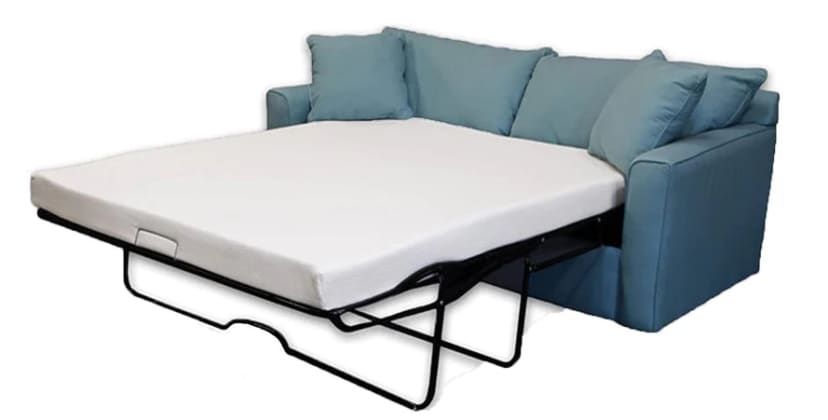
The Dynasty 4.0 Inch Gel Memory Foam Sofa Mattress is a lightweight design for compact spaces. It’s also a great option if you have a sofa bed and want to keep guests comfortable.
-
Pros
-
Sofa bed design is compact for easy storage
-
Stays relatively cool for an all-foam bed
-
Supportive enough for back and stomach sleepers under 230 pounds
-
-
Cons
-
Weaker pressure relief than other all-foam beds
-
Not cushy enough for most side sleepers in the long run
-
Mattress Type
Foam
Firmness Options
Medium Firm (6)
Price Range
$250 – $260
Trial Period
120 nights (30-night request)
How It Performed
This mattress is best for sleepers who don’t require significant contouring or support. Its high-density memory foam supported the stomach sleepers under 230 pounds on our team. The medium firm (6) surface offered balanced contouring for back sleepers between 130 and 230 pounds.
Pressure relief was marginal for side sleepers in all weight groups. The mattress might be acceptable for short-term use, but its comfort system is likely too thin for most side sleepers.
Our hot sleepers didn’t experience much heat buildup, which is uncommon for a memory foam mattress. The all-foam construction also dampens surface vibrations.
What It’s Made Of
The Dynasty 4.0 Inch Gel Memory Foam Sofa Mattress features two layers of memory foam. The mattress rates as medium firm (6), which is considered the most versatile firmness level. The top layer uses 2 inches of high-density memory foam with a cooling gel infusion. An additional 2-inch layer of memory foam reinforces heavier body parts. All of the foam is CertiPUR-US certified, indicating it’s free of a range of harmful chemicals.
The removable cover is a breathable blend of silk and polyester. It’s machine-washable, and there’s a zipper for easy removal. Shoppers can choose from full sofa and queen sofa sizes. Both options weigh significantly less than the typical mattress, so they are easier to transport to your RV, boat, or trailer.
The mattress is sold through the Dynasty Mattress website and Amazon. Dynasty Mattress offers free shipping to the contiguous U.S. A 120-night sleep trial and a 5-year warranty is also included.
The Bear Trek is an 8-inch foam mattress designed for RVs. It offers impressive support despite its thin profile, providing great support for most sleepers under 230 pounds.
-
Pros
-
Good pressure relief for a thin mattress
-
Stays relatively cool for hot sleepers
-
Available in multiple RV sizes
-
-
Cons
-
Lacking in support for most sleepers over 230 pounds
-
Less motion isolation than a typical all-foam bed
-
Mattress Type
Foam
Firmness Options
Firm (7)
Price Range
$549 – $799
Trial Period
120 nights (30-night break-in period)
How It Performed
The Bear Trek mattress didn’t sag excessively for our stomach and back sleepers under 230 pounds. Deep sinkage was an issue though for all of our testers over 230 pounds. Side sleepers between 130 and 230 pounds sank just enough to ease tension on the hips and shoulders.
We thought the mattress had standout edge support for an all-foam model. This should increase the mattress’ overall durability, especially for co-sleepers. Our combination sleepers found it easy to change positions since the surface is fairly responsive.
What It’s Made Of
The Bear Trek is a two-layer foam mattress designed for RVs. It’s 8 inches thick and rates as firm (7) on our 10-point firmness scale. The cover is a blend of polyester and Celliant, a synthetic fiber designed to convert body heat into far infrared radiation (FIR). The process is thought to improve physical recovery by increasing circulation and tissue oxygenation.
A 2-inch layer of memory foam provides moderate contouring. Gel infusions are designed to draw out heat. The 6-inch support core uses high-density polyfoam to stabilize the mattress.
Bear uses CertiPUR-US certified foams that meet strict quality and safety standards. The mattress is available in RV bunk, RV queen, and RV king sizes. Bear ships the mattress for free to the contiguous U.S. Customers are protected with a 120-night sleep trial and a limited lifetime warranty.
Expert Tested. Sleeper Approved.
Over the past eight years, our Seattle-based Test Lab has performed hands-on tests on more than 4,000 sleep products — and nearly 2,000 of them are mattresses.
As product experts, we stay up to date on the latest news in sleep science and product trends. We use this knowledge to fuel our data-backed recommendations. Many of our testers have worked directly with mattress manufacturers and visited actual mattress factories. On occasion, a sleep health expert might stop by to tweak a firmness rating.
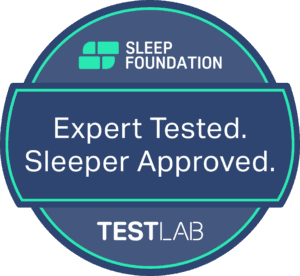
When we test a mattress, we collect data across six major performance categories and combine these results with real-world feedback. We use tools and tech to monitor features like heat retention, motion isolation, and pressure mapping. In order to ensure our findings are inclusive of all sleepers, our team consists of people with varying body types and sleep positions.
Mattresses aren’t one-size-fits-all. The perfect bed for you is going to depend on general points like your body weight and sleeping position, as well as unique points like if you have back pain, if you sleep hot at night, or if you just like the feel of latex over memory foam. Our goal at the Test Lab is to help take the guesswork out of your mattress-buying process.
Who Is a Thin Mattress Best For?
A thin mattress suits children or adults who benefit from moderate support and minimal sink. Lightweight back sleepers, stomach sleepers, and sleepers with back pain may benefit from a thin design with minimal contouring. People with mobility issues may find it easier to get in and out of a shorter bed.
Since thin mattresses usually cost less, they’re also great for budget shoppers and college students. Frequent movers appreciate that they weigh less than thicker models.
How to Choose a Thin Mattress
Each sleeper is unique when it comes to comfort preferences, budget, and space limitations. Even if the bed’s height is your top concern, it’s still a good idea to consider a mattress’ overall performance.
What to Look For in a Thin Mattress
Material quality, craftsmanship, and firmness level all impact the way a mattress feels. Most sleepers value certain performance features more than others. Hot sleepers, for example, should focus on breathable materials. Co-sleepers often prioritize strong edge support and motion isolation.
Make sure to evaluate your unique preferences when choosing a mattress style and height.
Price
Thin mattresses are generally less expensive than thicker models since they use less materials. This makes them great for college students and other shoppers on a budget. An inexpensive thin mattress may be a good fit for a guest bedroom that’s used only occasionally. The same goes for children who may need a bigger bed within a few years.
Sleeping Position
Whether on the side, back, or stomach, a person’s sleep position impacts the qualities they should look for in a mattress. Side sleepers generally need a mattress with plenty of cushioning. They’re prone to pressure points on the hips and shoulders if the comfort system doesn’t allow these heavier areas of the body to sink deeper into the surface.
Back sleepers don’t require much contouring, so a thin mattress can work so long as it reinforces the torso and doesn’t allow the lumbar area to sink too deeply into the bed.
Stomach sleepers usually need a firm mattress to support the midsection. While thin mattresses can work for this sleep position, stomach sleepers should ensure that they don’t bottom out on a mattress that’s too soft or thin.
Quality Materials
Mattresses made with higher quality materials generally last longer. Thinner mattresses sometimes wear faster since they have fewer layers, making material quality even more essential. High-quality materials are often more breathable, which is important if you tend to sleep hot.
Firmness Level
Firmness describes a mattress’ relative softness. Thin mattresses tend to have more minimal comfort systems, so they usually feel firmer compared to taller models. Body weight and sleep position also affect how firm a mattress feels. A mattress may feel too rigid for a side sleeper under 130 pounds. The same mattress might be too plush for a stomach sleeper over 230 pounds.
Pressure Relief
Painful pressure points can develop if a sleeper’s body weight isn’t evenly distributed. A mattress with notable pressure relief combines cushioning with the right level of support to maintain spinal alignment.
A low-profile mattress might not offer adequate pressure relief if the comfort layers are too thin. Pressure-relieving materials like memory foam or latex can compensate for a thinner comfort system. Also, not every sleeper needs substantial contouring to alleviate tension.
Motion Isolation
How well a mattress isolates motion depends on its materials and construction. Mattresses with coil-based or latex support systems usually transfer more movement from one side of the bed to the other. Foam, on the other hand, tends to be excellent at absorbing motion. Thin mattresses don’t have as many comfort layers to buffer movement, so it’s important to focus on the quality and performance of each layer.
Temperature Regulation
A mattress’ temperature regulation should be a priority for anyone who sleeps hot. Foam mattresses tend to retain more heat than hybrids with ventilated coil support cores. Some manufacturers use open-cell foams, gel infusions, and other cooling features to reduce heat buildup. Because they don’t permit as much sinkage, thin mattresses often sleep cooler than tall models.
Edge Support
A mattress with strong edge support feels more stable when lying or sitting near the edges. A low profile mattress with a sturdy perimeter can also make getting in and out of bed easier for people with back pain.
Contouring
Contouring in a mattress largely depends on its firmness and height. Tall mattresses usually conform more to sleepers’ bodies because they have thicker comfort systems. Contouring needs vary according to sleep position and body type. Side sleepers generally need more contouring than stomach and back sleepers.
Mattress Type
Mattresses are categorized according to their materials and construction method. Each mattress type has its pros and cons, and some benefit certain sleepers more than others. People who value ease of movement may want a bouncy hybrid. Couples might prefer a foam mattress that isolates motion well.
Types of Thin Mattresses
Mattresses are categorized according to their interior components and materials. Each type of mattress has notable features that appeal to certain sleepers more than others. Mattresses of the same type may perform very differently depending on material quality and workmanship.
Hybrid
A hybrid combines a comfort system with a pocketed coil support core. Comfort layers are commonly made from polyfoam, memory foam, latex, polyester, cotton, or wool. Hybrids are valued for their responsiveness, durability, and temperature control. A thin hybrid may be a good option for those looking for a low profile mattress that offers a combination of softness and support with plenty of bounce.
Innerspring
Innerspring mattresses have a coil-based support core and a minimal comfort system. Innerspring designs are often affordable, making them a frequent choice for children and people who don’t need a lot of contouring. It’s not hard to find low-profile innersprings since they don’t have as many comfort layers as other mattress types.
Foam
All-foam mattresses are made entirely of foam. They often have a high-density polyfoam core and softer foam comfort layers. Foam mattresses typically excel at pressure relief and motion isolation. One potential drawback is foam’s tendency to retain heat. Many manufacturers, however, use open-cell foams and gel infusions to minimize heat buildup.
Thin foam mattresses are exceptionally lightweight, so they’re great for RVs, boats, and dorm rooms. They also tend to be less expensive than other mattress types.
Latex
Latex mattresses have internal layers made exclusively from latex. The latex may be natural, synthetic, or a combination of both. Natural latex is manufactured using the Dunlop or Talalay methods. The former produces a denser latex, while the latter creates a springier feel.
Latex is known for its durability, responsiveness, and ventilation. It cushions pressure points but isn’t as body-conforming as memory foam. Natural latex mattresses are often considered luxury, so they tend to be taller overall. Even thinner latex models are usually more expensive than other types of mattresses.
Airbed
Airbeds feature a support core with an adjustable air chamber, allowing sleepers to modify its level of firmness. The comfort system on airbeds is highly variable, but may include memory foam, latex, or polyfoam layers.
With their sophisticated design, airbeds are some of the most expensive mattresses on the market. Most are at least 10 inches tall, since air chambers take up significant space. Manufacturers also tend to make airbeds taller to justify their luxury price-point.
Dive Deeper – In-Depth Mattress Guides
If you’re not sure you’ve found a bed that suits your needs, you can narrow down your search by reviewing our recommendations by mattress feel.
Best Mattress by Firmness Level
Frequently Asked Questions
Who is a thin mattress best for?
Children often sleep well on a thin mattress since they don’t sink as much into the comfort layers. Adults under 230 pounds can also feel supported on a low-profile design. Hot sleepers may find thin mattresses cooler since these beds are less body-conforming.
Since thin mattresses tend to cost less, they’re great for furnishing a guest bed or spare room on a budget. An inexpensive thin mattress also makes sense for a child who will probably need a larger mattress in the near future.
Can thin mattresses cause back pain?
Thin mattresses could contribute to back pain for people who need stronger support or softer comfort layers to maintain spinal alignment. However, thin mattresses can be an excellent choice for lighter individuals with back pain. As with any mattress, personal comfort and spinal alignment are key, so it’s important to consider individual needs and sleeping styles when selecting the right mattress thickness.
Is 6 inches too thin for a mattress?
A 6-inch mattress may be too thin to support sleepers who weigh more than 130 pounds. Heavier sleepers may sink excessively into a 6-inch mattress, causing poor spinal alignment. Many children, however, can sleep comfortably on a 6-inch mattress.
Is a thinner mattress better?
Thin mattresses have advantages for certain types of sleepers. People who like a firm surface with minimal contouring may prefer a thin mattress. Shorter beds are usually more accessible to young children and those with mobility issues. Thin mattresses are also more appropriate for small sleep spaces like RVs, bunk beds, or sofa beds.

Still have questions?
Our product experts have extensive experience testing just about every sleep product on the market. Send an email to AskAnExpert@sleepfoundation.org or call us at (877) 672-8966 with your questions and we’ll help you find exactly what you’re looking for.

